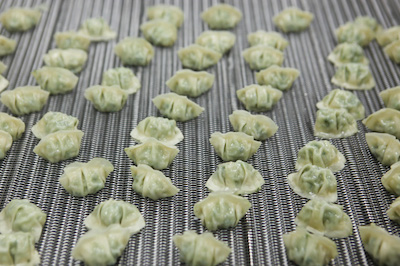With an emphasis on quality and authenticity, CYR International, Inc., is bringing the popular Korean dumplings to mainstream America.
Story by Katherine Yungmee Kim
Photographs by Elizabeth Kim
Donning a bouffant cap and white coat, Christian Park looks very much at home in an ultraviolet ray sterilizer. The unit is slightly larger than a telephone booth, and he stands there for several seconds as air—blown through short wavelengths of light—cleanses him from head to toe.
Park, the executive vice president and chief financial officer of CYR International, Inc., is entering his 25,000-square-foot mandu processing plant in a sunbeaten industrial neighborhood of Alhambra, California. The factory, with spotless Ucrete floors and huge stainless steel machines, has a maximum daily output of 3,500 boxes of the popular Korean dumplings, which can amount to a whopping 840,000 mandus rolling off the production lines every day.
But the goal is not just about volume. Rather, “we pride ourselves on quality,” says Park, who founded the CYR food manufacturing company with partner Eunchan Lim about five years ago. They opened the mandu factory in July 2009. “We cut no corners when building our facility. We welcome anyone and everyone to visit [it].”
The dumplings’ fillings are mixed by machine, squirted into a thin dough wrapper, shaped, steamed at 160 degrees—to kill any possibility of listeria—and then frozen instantly. A USDA inspector is always present in the facility to oversee production.
The emphasis at CYR is also on top-notch ingredients—lean pork meat, all-natural chicken, fresh napa cabbage—and traditional recipes that date back over 60 years. The management scouted for workers from South Korea who had experience in mandu making “to ensure that we honor the authenticity and quality of our dumplings,” says Park.
Factory manager Keon Park (no relation to Christian) was one of the handpicked experts from Korea. He worked in the food industry for 15 years, 10 of which were spent at a leading mandu manufacturer. His area of expertise lends to CYR’s prized dumpling distinction: a perfect outer skin.
“There’s a special ratio of water to flour and air vacuuming that makes the dough very chewy,” Keon Park explains. “Even if the ratio is off by 0.1 percent, the dough can easily break.”
Mandu is much-loved, traditional Korean fare. Though it is enjoyed year-round, it is always eaten to celebrate the New Year, including the Lunar New Year. Many families have memories of sitting around the kitchen, wrapping the meat in flat flour pi and lining the crescent-shaped confections in rows on baking sheets.
It is believed that mandu was brought to Korea during the Goryeo Dynasty by way of the Mongols in the 14th century. Similar to Slavic pierogi and Turkish manti, mandu is generally a meat-filled dumpling, but Koreans have put their spin on the ingredients to create a nutritious combination of meat, tofu and vegetables. There’s pork and leek mandu, kimchi mandu and vegetarian mandu, often made with clear noodles. It’s served every which way—fried, steamed, boiled, in soup, as an appetizer and as a main dish—and in a variety of shapes and sizes.
“Although mandu is a Korean food, many other cultures have a similar type of dumpling,” says Lim, chief executive officer of CYR, who largely handles the Korean side of business affairs. “Gyoza in Japan, ravioli in Italy, empanadas in Mexico… the introduction of mandu to other ethnic groups is not a new concept. The similarities will make our mandu more appealing.”
There are three different brands manufactured at the CYR factory: Cham Yi Rang, aka CYR, is the line for the Korean American retailers; Lim’s Food is the brand sold at Latino markets; and Green Chopsticks is the “all-natural” brand for the Western markets, a line that has been granted a coveted spot in the frozen foods section of several Southern California Whole Foods Markets.
Chris Besancon, a team member at the Tarzana Whole Foods Market, says that in order to be sold in the store, products “can’t have artificial flavors, preservatives or colors.” Green Chopsticks is MSG-free, has a line of handmade spring rolls with julienned vegetables and is launching a children’s line of bite-sized dumplings. CYR also produces mandu for Pulmuone, a popular Korean company that touts sustainability and natural foods.
According to Asian Foods: Science and Technology, frozen dumplings have been available in East Asia since the mid-1970s. Though some 30-plus competitors line the aisle of freezers in the Korean markets, Christian Park is confident that the CYR products will persevere.
And as for how the economy has affected the new business, Park responds matter-of-factly. “The food industry, unlike many other industries, has not been greatly affected by the recession,” he says. “People still have to eat.”
Park, a pastor’s son, moved with his family from Kangwon province in northeastern Korea to Anchorage, Alaska, when he was 9 years old. Although Park says he grew up eating mandu with his sisters at the pojang macha (street stalls) in his hometown of Wonju, he never intended to make dumplings for a living.
“We actually got into this business by chance,” he notes. “I was about to start my MBA at the University of Southern California, and I thought I could go to school and do this on the side.”
In early 2004, Park was working at a boutique consulting firm in Los Angeles when Lim learned through family members in Korea that a leading mandu company—Chew Young Roo—was looking for a distribution and marketing company in America. Park and Lim devised a business plan, submitted it and won the bid.
“In the beginning, we did everything from sales to deliveries to marketing,” Park recalls. “The first day, we rented a U-Haul truck to deliver the mandu by ourselves to five or six markets in the rain.”
Fortuitously, the dumplings hit the markets in Los Angeles and Orange Counties on the weekend of December 31 and with the help of food demos and the New Year’s holiday, many of the markets sold out. “It was great timing,” Park admits.
Eventually, by the end of 2005, they had the mandu placed in all of the Korean American markets. With their footing in the Korean stores firmly established, the two set their sights on the American marketplace, approaching large stores like Costco and Albertson’s. “But we hit a wall,” explains Park.
Because of the trade restrictions placed on meat products (largely due to diverse national standards regarding foodborne pathogens, as well as powerful U.S. beef industry lobbyists), only fish and vegetable dumplings can be imported from South Korea. But the U.S. markets have a high demand for meat products. Park and Lim realized that to set their sights on the next horizon, they needed to produce the dumplings domestically.
It took almost two years to secure the right building space for the dumpling factory and another two years to complete renovations, largely due to the time it took to obtain the proper permits. But Park used that time wisely. In between “riding his bike and playing baseball in the factory,” Park networked in the local business community. He joined the Alhambra Chamber of Commerce and the town’s Rotary Club and YMCA. He developed a company culture characterized by a “small-family” vibe among the firm’s 40 employees, who are 55 percent Latino, 40 perent Korean and 5 percent white.
In CYR’s first year of production, sales reached $4 million. Park anticipates that by 2011, annual sales will double to $8 million, primarily due to its entrance into the mass market. The company opened its first food court restaurant, Cham Yi Rang in an H-Mart Supermarket in Norwalk, California, in early 2010, serving wang mandu, a large round steamed bun, in addition to other types of mandu.
In October, the mandu maker is launching its “Costco Road Show” with food demos across Southern California, and CYR products will be available in the southeastern U.S. Costcos in December.
Though people call him the “Mandu King,” that moniker might not stick forever. CYR has already purchased a kalguksu machine, and they have played around with producing the handcut noodles, as well as packaged Asian-style meals like Annie Chun’s and meat products like bulgogi and galbi.
“The demand for Asian food has grown steadily,” Park comments, attributing the sales growth to its “healthy” reputation. There is increasingly more shelf space for Asian food products in large mainstream American markets, a trend he connects to the nation’s increasing diversity. “There’s an awareness in the American people to try out more ethnic foods.”
Park shrugs off the other manufacturers; there are five other Korean mandu factories (not to mention Chinese and Japanese producers) in California alone.
“The market is big enough for us to survive,” the business school grad says with a smile, clearly motivated. “A little competition never hurts.









